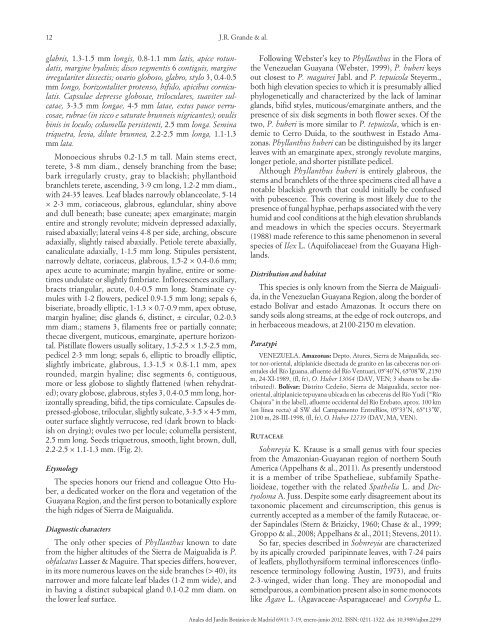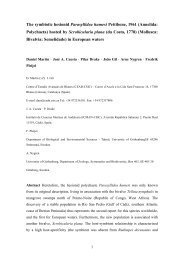Botanical novelties from Sierra de Maigualida, southern ... - CSIC
Botanical novelties from Sierra de Maigualida, southern ... - CSIC
Botanical novelties from Sierra de Maigualida, southern ... - CSIC
Create successful ePaper yourself
Turn your PDF publications into a flip-book with our unique Google optimized e-Paper software.
12 J.R. Gran<strong>de</strong> & al.<br />
glabris, 1.3-1.5 mm longis, 0.8-1.1 mm latis, apice rotundatis,<br />
margine hyalinis; disco segmentis 6 contiguis, margine<br />
irregulariter dissectis; ovario globoso, glabro, stylo 3, 0.4-0.5<br />
mm longo, horizontaliter protenso, bifido, apicibus corniculatis.<br />
Capsulae <strong>de</strong>presse globosae, triloculares, suaviter sulcatae,<br />
3-3.5 mm longae, 4-5 mm latae, extus pauce verrucosae,<br />
rubrae (in sicco e saturate brunneis nigricantes); ovulis<br />
binis in loculo; columella persistenti, 2.5 mm longa. Semina<br />
triquetra, levia, dilute brunnea, 2.2-2.5 mm longa, 1.1-1.3<br />
mm lata.<br />
Monoecious shrubs 0.2-1.5 m tall. Main stems erect,<br />
terete, 3-8 mm diam., <strong>de</strong>nsely branching <strong>from</strong> the base;<br />
bark irregularly crusty, gray to blackish; phyllanthoid<br />
branchlets terete, ascending, 3-9 cm long, 1.2-2 mm diam.,<br />
with 24-35 leaves. Leaf bla<strong>de</strong>s narrowly oblanceolate, 5-14<br />
× 2-3 mm, coriaceous, glabrous, eglandular, shiny above<br />
and dull beneath; base cuneate; apex emarginate; margin<br />
entire and strongly revolute; midvein <strong>de</strong>pressed adaxially,<br />
raised abaxially; lateral veins 4-8 per si<strong>de</strong>, arching, obscure<br />
adaxially, slightly raised abaxially. Petiole terete abaxially,<br />
canaliculate adaxially, 1-1.5 mm long. Stipules persistent,<br />
narrowly <strong>de</strong>ltate, coriaceus, glabrous, 1.5-2 × 0.4-0.6 mm;<br />
apex acute to acuminate; margin hyaline, entire or sometimes<br />
undulate or slightly fimbriate. Inflorescences axillary,<br />
bracts triangular, acute, 0.4-0.5 mm long. Staminate cymules<br />
with 1-2 flowers, pedicel 0.9-1.5 mm long; sepals 6,<br />
biseriate, broadly elliptic, 1-1.3 × 0.7-0.9 mm, apex obtuse,<br />
margin hyaline; disc glands 6, distinct, ± circular, 0.2-0.3<br />
mm diam.; stamens 3, filaments free or partially connate;<br />
thecae divergent, muticous, emarginate, aperture horizontal.<br />
Pistillate flowers usually solitary, 1.5-2.5 × 1.5-2.5 mm,<br />
pedicel 2-3 mm long; sepals 6, elliptic to broadly elliptic,<br />
slightly imbricate, glabrous, 1.3-1.5 × 0.8-1.1 mm, apex<br />
roun<strong>de</strong>d, margin hyaline; disc segments 6, contiguous,<br />
more or less globose to slightly flattened (when rehydrated);<br />
ovary globose, glabrous, styles 3, 0.4-0.5 mm long, horizontally<br />
spreading, bifid, the tips corniculate. Capsules <strong>de</strong>pressed-globose,<br />
trilocular, slightly sulcate, 3-3.5 × 4-5 mm,<br />
outer surface slightly verrucose, red (dark brown to blackish<br />
on drying); ovules two per locule; columella persistent,<br />
2.5 mm long. Seeds triquetrous, smooth, light brown, dull,<br />
2.2-2.5 × 1.1-1.3 mm. (Fig. 2).<br />
Etymology<br />
The species honors our friend and colleague Otto Huber,<br />
a <strong>de</strong>dicated worker on the flora and vegetation of the<br />
Guayana Region, and the first person to botanically explore<br />
the high ridges of <strong>Sierra</strong> <strong>de</strong> <strong>Maigualida</strong>.<br />
Diagnostic characters<br />
The only other species of Phyllanthus known to date<br />
<strong>from</strong> the higher altitu<strong>de</strong>s of the <strong>Sierra</strong> <strong>de</strong> <strong>Maigualida</strong> is P.<br />
obfalcatus Lasser & Maguire. That species differs, however,<br />
in its more numerous leaves on the si<strong>de</strong> branches (> 40), its<br />
narrower and more falcate leaf bla<strong>de</strong>s (1-2 mm wi<strong>de</strong>), and<br />
in having a distinct subapical gland 0.1-0.2 mm diam. on<br />
the lower leaf surface.<br />
Following Webster’s key to Phyllanthus in the Flora of<br />
the Venezuelan Guayana (Webster, 1999), P. huberi keys<br />
out closest to P. maguirei Jabl. and P. tepuicola Steyerm.,<br />
both high elevation species to which it is presumably allied<br />
phylogenetically and characterized by the lack of laminar<br />
glands, bifid styles, muticous/emarginate anthers, and the<br />
presence of six disk segments in both flower sexes. Of the<br />
two, P. huberi is more similar to P. tepuicola, which is en<strong>de</strong>mic<br />
to Cerro Duida, to the southwest in Estado Amazonas.<br />
Phyllanthus huberi can be distinguished by its larger<br />
leaves with an emarginate apex, strongly revolute margins,<br />
longer petiole, and shorter pistillate pedicel.<br />
Although Phyllanthus huberi is entirely glabrous, the<br />
stems and branchlets of the three specimens cited all have a<br />
notable blackish growth that could initially be confused<br />
with pubescence. This covering is most likely due to the<br />
presence of fungal hyphae, perhaps associated with the very<br />
humid and cool conditions at the high elevation shrublands<br />
and meadows in which the species occurs. Steyermark<br />
(1988) ma<strong>de</strong> reference to this same phenomenon in several<br />
species of Ilex L. (Aquifoliaceae) <strong>from</strong> the Guayana Highlands.<br />
Distribution and habitat<br />
This species is only known <strong>from</strong> the <strong>Sierra</strong> <strong>de</strong> <strong>Maigualida</strong>,<br />
in the Venezuelan Guayana Region, along the bor<strong>de</strong>r of<br />
estado Bolívar and estado Amazonas. It occurs there on<br />
sandy soils along streams, at the edge of rock outcrops, and<br />
in herbaceous meadows, at 2100-2150 m elevation.<br />
Paratypi<br />
VENEZUELA. Amazonas: Depto. Atures, <strong>Sierra</strong> <strong>de</strong> <strong>Maigualida</strong>, sector<br />
nor-oriental, altiplanicie disectada <strong>de</strong> granito en las cabeceras nor-orientales<br />
<strong>de</strong>l Río Iguana, afluente <strong>de</strong>l Río Ventuari, 05º40’N, 65º08’W, 2150<br />
m, 24-XI-1989, (fl, fr), O. Huber 13064 (DAV, VEN; 3 sheets to be distributed).<br />
Bolívar: Distrito Ce<strong>de</strong>ño, <strong>Sierra</strong> <strong>de</strong> <strong>Maigualida</strong>, sector nororiental,<br />
altiplanicie tepuyana ubicada en las cabeceras <strong>de</strong>l Río Yudi [“Río<br />
Chajura” in the label], afluente occi<strong>de</strong>ntal <strong>de</strong>l Río Erebato, aprox. 100 km<br />
(en línea recta) al SW <strong>de</strong>l Campamento EntreRíos, 05º33’N, 65º13’W,<br />
2100 m, 28-III-1998, (fl, fr), O. Huber 12739 (DAV, MA, VEN).<br />
RUTACEAE<br />
Sohnreyia K. Krause is a small genus with four species<br />
<strong>from</strong> the Amazonian-Guayanan region of northern South<br />
America (Appelhans & al., 2011). As presently un<strong>de</strong>rstood<br />
it is a member of tribe Spathelieae, subfamily Spathelioi<strong>de</strong>ae,<br />
together with the related Spathelia L. and Dic -<br />
tyoloma A. Juss. Despite some early disagreement about its<br />
taxonomic placement and circumscription, this genus is<br />
currently accepted as a member of the family Rutaceae, or<strong>de</strong>r<br />
Sapindales (Stern & Brizicky, 1960; Chase & al., 1999;<br />
Groppo & al., 2008; Appelhans & al., 2011; Stevens, 2011).<br />
So far, species <strong>de</strong>scribed in Sohnreyia are characterized<br />
by its apically crow<strong>de</strong>d paripinnate leaves, with 7-24 pairs<br />
of leaflets, phyllothyrsiform terminal inflorescences (inflorescence<br />
terminology following Austin, 1973), and fruits<br />
2-3-winged, wi<strong>de</strong>r than long. They are monopodial and<br />
semelparous, a combination present also in some monocots<br />
like Agave L. (Agavaceae-Asparagaceae) and Corypha L.<br />
Anales <strong>de</strong>l Jardín Botánico <strong>de</strong> Madrid 69(1): 7-19, enero-junio 2012. ISSN: 0211-1322. doi: 10.3989/ajbm.2299
















